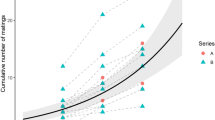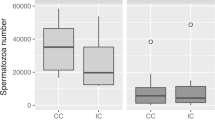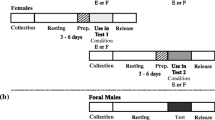Abstract
In many animal species, mating behaviour is highly ritualised, which may allow us to relate some of its consequences, e.g. male paternity and female receptivity, to the progression of phases in the mating sequence; at the same time, ritualisation raises the question of to what extent the partners, especially the males, are able to influence the outcome of mating for their own benefit. We studied the linyphiid spider Linyphia triangularis in which mating follows a strict sequence during which the male inducts two droplets of sperm and transfers them to the female. We performed sperm competition experiments (sterile-male technique) including four treatments, in which the copulation of the first male was interrupted at prescribed phases of the mating sequence, while the second male was allowed a complete mating. Second males spent a shorter time than first males on the behaviours prior to sperm transfer, but the amount of sperm (2 droplets) and the time spent in sperm transfer were independent of the females’ mating status. The proportion of females accepting the second male depended on the mating duration of the first male, i.e. whether the first male had transferred one or two sperm droplets. After a complete first mating, most females accepted no further males. A last-male sperm precedence was apparent if only half of the first sperm droplet had been transferred by the first male, but this switched to a first male precedence if one full sperm droplet had been transferred. Thus, even in the face of sperm competition, it is sufficient for the first male to transfer one sperm droplet. The second sperm droplet and the extended copulatory courtship associated with its transfer may serve to induce a lack of receptivity in the female, but the males seem unable to enhance their reproductive success through variable copulatory tactics.

Similar content being viewed by others
References
Aisenberg A, Estramil N, Toscano-Gadea C, Gonzalez M (2009) Timing of female sexual unreceptivity and male adjustment of copulatory behaviour under competition risk in the wolf spider Schizocosa malitiosa. J Ethol 27:43–50
Arnquist G, Nilsson T (2000) The evolution of polyandry: multiple mating and female fitness in insects. Anim Behav 60:145–164
Austad SN (1982) First male sperm priority in the bowl and doily spider, Frontinella pyramitela (Walckenaer). Evolution 36:777–785
Austad SN (1983) A game-theoretical interpretation of male combat in the bowl and doily spider (Frontinella pyramitela). Anim Behav 31:59–73
Austad SN (1984) Evolution of sperm priority patterns in spiders. In: Smith RL (ed) Sperm competition and the evolution of animal mating systems. Academic, London, pp 233–249
Boorman E, Parker GA (1976) Sperm (ejaculate) competition in Drosophila melanogaster, and the reproductive value of females to males in relation to female age and mating status. Ecol Entomol 1:145–155
Bukowski TC, Christenson TE (1997) Determinants of sperm release and storage in a spiny orbweaving spider. Anim Behav 53:381–395
Drengsgaard IL, Toft S (1999) Sperm competition in a nuptial feeding spider, Pisaura mirabilis. Behaviour 136:877–897
Eberhard WG (1996) Female control: sexual selection by cryptic female choice. Princeton University Press, Princeton
Elgar MA (1995) The duration of copulation in spiders: comparative patterns. Rec West Aust Mus Suppl 52:1–11
Elgar MA (1998) Sperm competition and sexual selection in spiders and other arachnids. In: Birkhead TR, Møller AP (eds) Sperm competition and sexual selection. Academic, San Diego, pp 307–339
Elgar MA, Bathgate R (1996) Female receptivity and male mate-guarding in the jewel spider Gasteracantha minax Thorell (Araneidae). J Insect Behav 9:729–738
Hosken DJ, Stockley P, Tregenza T, Wedell N (2009) Monogamy and the battle of the sexes. Annu Rev Entomol 54:361–378
Jackson RR (1980) The mating strategy of Phidippus johnsoni (Araneae, Salticidae): II. Sperm competition and the function of copulation. J Arachnol 8:217–240
Jones TC, Parker PG (2008) First male sperm precedence in multiply-mated females of the cooperative spider Anelosimus studiosus (Araneae, Theridiidae). J Arachnol 36:527–532
Lynn CD, Molina Y, Difatta J, Christenson TE (2007) The adaptive advantage of prolonged mating: a test of alternative hypotheses. Anim Behav 74:481–485
Nielsen N, Toft S (1990) Alternative male mating strategies in Linyphia triangularis (Araneae, Linyphiidae). Acta Zool Fenn 190:293–297
Norton S, Uetz GW (2005) Mating frequency in Scizocosa ocreata (Hentz) wolf spiders: evidence for a mating system with female monandry and male polygyny. J Arachnol 33:16–24
Parker GA (1970) Sperm competition and its evolutionary consequences in the insects. Biol Rev 45:525–567
Perez-Miles F, Postiglioni R, Montes-de-Oca L, Baruffaldi L, Costa FG (2007) Mating system in the tarantula spider Eupalaestrus weijenberghi (Thorell, 1894): evidences of monandry and polygyny. Zoology 110:253–260
Poiani A (2006) Complexity of seminal fluid: a review. Behav Ecol Sociobiol 60:289–310
Rovner JS (1967) Copulation and sperm induction by normal and palpless male linyphiid spiders. Science 157:835
Rovner JS (1968) Territoriality in the sheet-web spider Linyphia triangularis (Araneae, Linyphiidae). Z Tierpsychol 25:232–242
Schulz S, Toft S (1993) Identification of a sex pheromone in a spider. Science 260:1635–1637
Simmons LW (2002) Sperm competition and its evolutionary consequences in the insects. Princeton University Press, Princeton
Singer F, Reichert SE (1995) Mating system and mating success of the desert spider Agelenopsis aperta. Behav Ecol Sociobiol 36:313–322
Snow LSE, Andrade MCB (2005) Multiple sperm storage organs facilitate female control of paternity. Proc R Soc Lond B 272:1139–1144
Stumpf H (1990) Observations on the copulation behaviour of the sheet-web spiders Linyphia hortensis Sundevall and Linyphia triangularis (Clerck) (Araneae: Linyphiidae). Bull Soc Eur Arachnol Hors Ser 1:340–345
Suhm M, Thaler K, Alberti G (1995/1996) Glands in the male palpal organ and the origin of the mating plug in Amaurobius species (Araneae: Amaurobiidae). Zool Anz 234:191–199
Suter RB (1990) Courtship and assessment of virginity by male bowl and doily spiders. Anim Behav 39:307–313
Suter RB, Parkhill VS (1990) Fitness consequences of prolonged copulation in the bowl and doily spider. Behav Ecol Sociobiol 26:369–373
Thornhill R, Alcock J (1983) The evolution of insect mating systems. Harvard University Press, Cambridge
Toft S (1989) Mate guarding in two Linyphia species (Araneae: Linyphiidae). Bull Br Arachnol Soc 8:33–37
Uhl G (2002) Female genital morphology and sperm priority patterns in spiders (Araneae). In: Toft S, Scharff N (eds) European arachnology 2000. Aarhus University Press, Århus, pp 145–156
Uhl G, Gunnarsson B (2001) Female genitalia in Pityohyphantes phrygianus, a spider with a skewed sex ratio. J Zool 255:367–376
van Helsdingen PJ (1965) Sexual behaviour of Lepthyphantes leprosus (Ohlert) (Araneida, Linyphiidae), with notes on the function of the genital organs. Zool Meded 41:15–42
van Helsdingen PJ (1983) Mating sequence and transfer of sperm as a taxonomic character in Linyphiidae (Arachnida: Araneae). Verh Naturwiss Ver Hambg (N.F.) 26:227–240
Watson PJ (1986) Transmission of a female sex pheromone thwarted by males in the spider Linyphia litigiosa (Linyphiidae). Science 233:219–221
Watson PJ (1990) Female-enhanced male competition determines the first mate and principal sire in the spider Linyphia litigiosa (Linyphiidae). Behav Ecol Sociobiol 26:77–90
Watson PJ (1991a) Multiple paternity and first mate sperm precedence in the sierra dome spider, Linyphia litigiosa Keyserling (Linyphiidae). Anim Behav 41:135–148
Watson PJ (1991b) Multiple paternity as genetic bet-hedging in female sierra dome spiders (Linyphia litigiosa: Linyphiidae). Anim Behav 41:343–360
Watson PJ (1993) Foraging advantage of polyandry for female sierra dome spiders (Linyphia litigiosa: Linyphiidae) and assessment of alternative direct benefit hypothesis. Am Nat 141:440–465
Watson PJ (1998) Multi-male mating and female choice increase offspring growth in the spider Neriene litigiosa (Linyphiidae). Anim Behav 55:387–403
Zeh JA, Zeh DW (2001) Reproductive mode and the genetic benefits of polyandry. Anim Behav 61:1051–1063
Acknowledgments
We are indebted to Jørn Erik Andersen, Odense University Hospital, for irradiating our male spiders, and to Paul Watson, Matjaz Kuntner and an anonymous reviewer for critical comments on previous versions. S.T. was supported by grants from the Danish research councils (FNU) and from the Carlsberg Foundation.
Author information
Authors and Affiliations
Corresponding author
About this article
Cite this article
Weldingh, D.L., Toft, S. & Larsen, O.N. Mating duration and sperm precedence in the spider Linyphia triangularis . J Ethol 29, 143–152 (2011). https://doi.org/10.1007/s10164-010-0237-x
Received:
Accepted:
Published:
Issue Date:
DOI: https://doi.org/10.1007/s10164-010-0237-x




